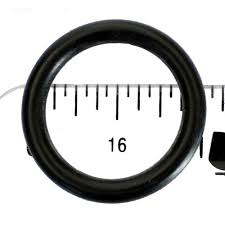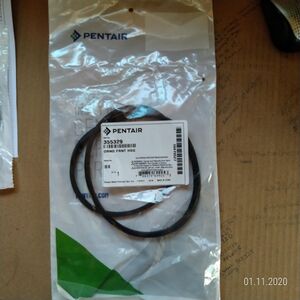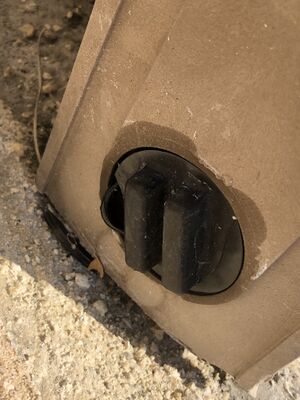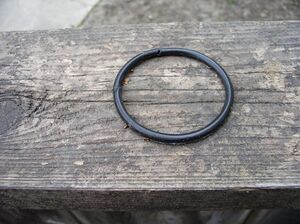| Line 6: | Line 6: | ||
[[File:O-Ring Pentair.jpg|thumb]] | [[File:O-Ring Pentair.jpg|thumb]] | ||
| − | The basic core polymer of an elastomeric compound is called a rubber, produced either as natural gum rubber in the wild, on commercial rubber plantations or manufactured synthetically by the chemical industry. Most O-rings we see in pools are Buna N 55 hardness. Buna is one of the most widely used O-Ring elastomer compounds | + | The basic core polymer of an elastomeric compound is called a rubber, produced either as natural gum rubber in the wild, on commercial rubber plantations or manufactured synthetically by the chemical industry. Most O-rings we see in pools are Buna N 55 hardness. Buna is one of the most widely used O-Ring elastomer compounds and is a Nitrile compound. The actual name is Acrylonitrile-Butadiene and can be referred to as Buna, Nitrile or NBR. Buna has heat resistance up to 212F (100C) and cold flexibility down to between -30F and -70F depending on compound. |
For more details about O-Rings see the [https://www.parker.com/content/dam/Parker-com/Literature/O-Ring-Division-Literature/ORD-5700.pdf Parker O-Ring Handbook] | For more details about O-Rings see the [https://www.parker.com/content/dam/Parker-com/Literature/O-Ring-Division-Literature/ORD-5700.pdf Parker O-Ring Handbook] | ||
Revision as of 21:55, 24 December 2022
O-Rings
O-rings are used throughout a pools plumbing to create watertight seals. You find large O-rings sealing the joints of filter to small O-rings sealing rotating valve stems. O-rings are used to create water tight seals around threaded fittings.
An O-ring is a doughnut shaped ring molded from an elastomer.
The basic core polymer of an elastomeric compound is called a rubber, produced either as natural gum rubber in the wild, on commercial rubber plantations or manufactured synthetically by the chemical industry. Most O-rings we see in pools are Buna N 55 hardness. Buna is one of the most widely used O-Ring elastomer compounds and is a Nitrile compound. The actual name is Acrylonitrile-Butadiene and can be referred to as Buna, Nitrile or NBR. Buna has heat resistance up to 212F (100C) and cold flexibility down to between -30F and -70F depending on compound.
For more details about O-Rings see the Parker O-Ring Handbook
O-Rings? O-Yeah! How to Select, Design, and Install O-Ring Seals is a great video about O-Rings.
O-Ring Wear and Tear
O-Rings may last 5 to 10 years, they don't last forever. O-Rings will often wear out and need replacement before the equipment does.
Ozone, weather and atmospheric aging can make O-Rings brittle and lose their flexibility. O-Rings in rotating shaft seals in pumps, valves, and actuators can wear from the friction of the shaft movement.
If a threaded joint develops a drip suspect that an O-Ring needs to be replaced.
O-Ring Sources
Check the Installation Manual for your equipment to find the manufacturers O-Ring part numbers.
Many O-rings are a commodity and can be found at hardware stores for much less then when packaged by a pool company. The advantage to paying pool company prices is you know you are getting the correct size O-Ring with the required materials.
O-Rings, Inc. is a leading online supplier of quality O-Rings.
allorings has a O-Ring Size Chart - AS568 Standard O-Ring Sizes that finds AS568 o-ring standard sizes by cross section, inside diameter and outside diameter in our o-ring size chart and separate o-ring tolerance chart.
Aladdin Equipment Company, Inc. makes many of the O-Rings and GO-KITs manufacturers use. Note that Aladdin has their own proprietary O- numbering standard for O-Rings that is different then the AS-568 standard.[1] Aladdin has a Parts Cross Reference on their website.
Tightening O-Rings
O-rings sit in a groove (or gland) and seal through compression. Any joint sealing with an O-ring should not be over-tightened. Over-tightening an O-ring joint can deform the O-ring and lead to leaks. Generally, fittings with o-rings only need to be "hand tight." You might need a wrench to loosen such a fitting, but you shouldn't use a wrench to put it back together if you can avoid it. If your hands are not strong enough to tighten a fitting enough, then you can gently use a wrench, but only to make the fitting a bit more snug than you could with your hands. You don't crank the fitting down.
If a fitting with an O-ring is leaking do not simply crank it down to try and stop the leak. That can crack the union, or pipe, or further deform the O-ring. Open up the joint and examine the O-ring for nicks, cracks or deterioration. Replace the O-ring if it is damaged or has lost its flexibility and is deformed.
Below shows a filter drain plug that was overtightened and the O-ring deformed:
Below is an O-Ring that was nicked and damaged:
O-Rings Need to be Lubed
All O-rings seal better when Pool Lube is used on them. Pool Lube should be used on all new O-rings and small leaks can often be stopped with an application of Pool Lube.
O-ring lube allows the three surfaces involved (the ring and the two components it's sealing together) to slide together as you tighten things up.[2] Without it, the ring will pinch and bind and deform. It's the deformation that causes the leaks. And the premature wear. So the lube is not really adding to the sealing properties of the ring, rather it allows the ring to retain its correct shape and do its job. And in that way it can lengthen the ring's life. Cleaning the ring and the surfaces it touches is important because a chunk of dirt can also deform the ring and cause a leak.





